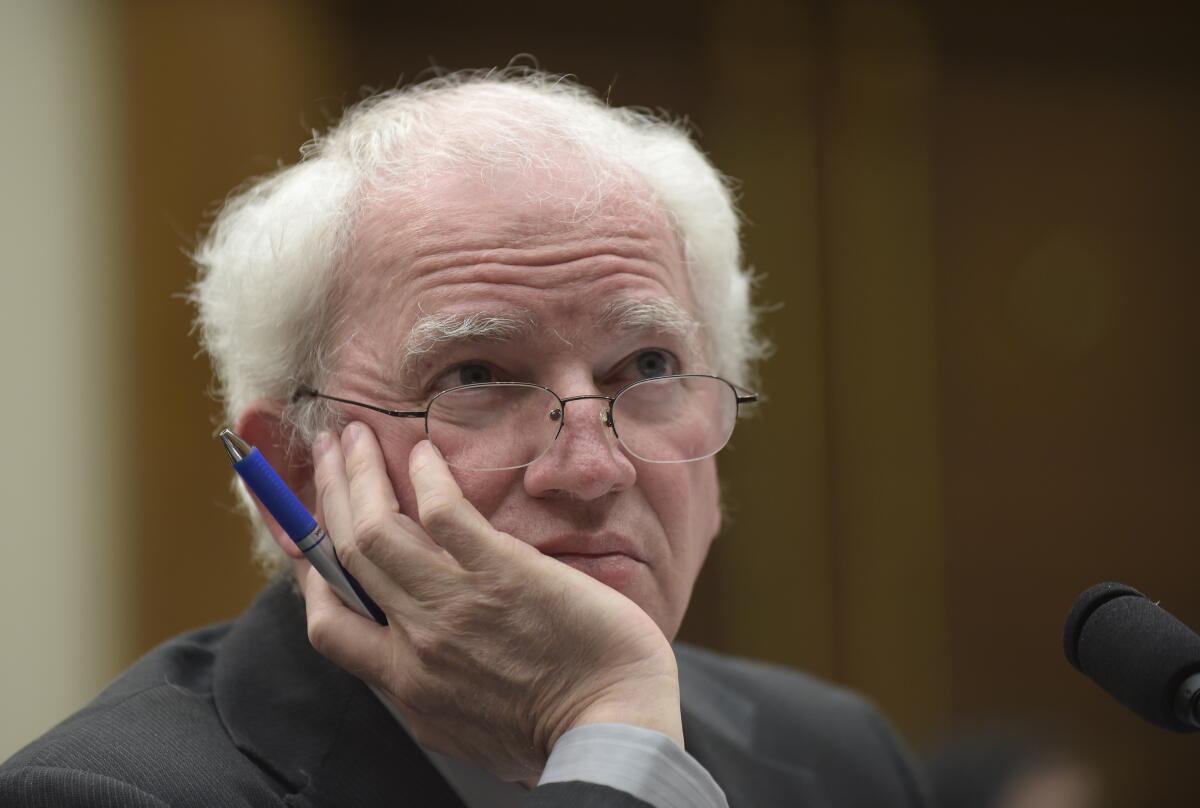Apodaca: Chapman dean’s retirement begs the question: How far is too far?

)
- Share via
Many years ago I was working on a volunteer project in my son’s elementary school class when I heard the teacher make an incorrect statement regarding how women should be addressed.
I stole a look at my son. Our eyes met, and I could see by his expression that he had noticed too.
That night we talked about it. He said he knew that the teacher had been wrong, but we agreed that the statement could be attributed to misinformation or misinterpretation and had not been intended to be disrespectful.
There were other incidents that were less innocent, including another teacher’s homophobic comments and a coach’s bigoted remarks. To my knowledge, neither of them were subject to any negative consequences as a result.
But I have often pondered the questions of how far is too far and when educators should be sanctioned for flagrantly offensive language or conduct.
When is the line crossed from objectionable or even abhorrent to actionable?
It’s a legal question, certainly, but it’s also a question of how much our society and institutions are willing to tolerate. And it’s a question that has held great relevance in recent days, as an argument flared over the whether a Chapman University professor should be fired for his role in the White House rally on the day a violent mob stormed the Capitol.
The controversy culminated in the Jan. 13 announcement that John Eastman, a Chapman constitutional law scholar and former law school dean, would retire, effective immediately, and that the university and Eastman “have agreed not to engage in legal actions of any kind.”
This followed several tense days during which Chapman President Daniele Struppa came under fire for his decision not to fire Eastman.
Indeed, Struppa was adamant that he could not force Eastman out.
“I am not the emperor of Chapman University, nor I am the supreme leader of Chapman University,” he said in a statement. “I am the president of the university, and as such, I am bound by laws and processes that are clearly spelled out in our faculty manual.”
Though he had previously acknowledged that Eastman “played a role in the tragic events in Washington, D.C., that jeopardized our democracy,” the law professor had not been convicted of a crime or disbarred, Struppa said. The statement seemed to imply that those would be the only two legitimate reasons for dismissal.
Oh, to have been a fly on the wall during the discussion that led to Eastman’s retirement. In a statement, Eastman said he left Chapman “with mixed feelings” but that colleagues had “created such a hostile environment for me that I no longer wish to be a member of the Chapman faculty.”
He was no doubt referring to the more than 160 Chapman faculty members who signed a Jan. 8 letter calling for Eastman to be disqualified from teaching at Chapman and stripped of his endowed chair.
The retirement of law professor John Eastman comes after days of campus controversy about his appearance at the “Save America” rally on Jan. 6.
I wonder if Eastman is aware of the irony in his complaint about a “hostile environment,” in light of the violence unleashed on another workplace, the nation’s Capitol, where lawmakers cowered in fear for their lives.
It’s worth noting that Eastman was an incendiary figure even before the events of Jan. 6. A former candidate for California attorney general the year that Kamala Harris was elected to the post, Eastman has advanced a despicable birther theory about Harris’ citizenship status that he contends disqualifies her from serving as vice president.
As part of President Trump’s legal team, Eastman promoted false narratives about voter fraud and a stolen election.
At the White House rally, he stood behind Rudy Giuliani, who called for “trial by combat.”
In his own volatile remarks, Eastman told the crowd an outlandish story about ballots in the Nov. 3 election being unloaded from a “secret folder,” and claimed that the process had been repeated in the Jan. 5 Senate runoff elections in Georgia.
The Chapman faculty members, in their statement, noted that they had expressed outrage over Eastman’s conduct previously, but it wasn’t until he “helped incite a riot against the U.S. government” that they concluded Chapman must sever all ties with him.
If the university failed to act, they wrote, the faculty, alumni and staff would be damaged by association.
“More importantly,” they argued, “our students deserve better.”
Now, with Eastman’s retirement, one might conclude that their concern has been rendered moot.
I recently spoke about this episode with my son — the one who, as a grade-school kid, could discern the difference between a teacher’s mistake and something darker and more destructive. He is now a law student at another university.
We discussed the nuances of employment law, the difficulties in firing a tenured professor and the need to be cognizant of the potential for setting a precedent that could be used later in unintended ways.
“From a more general perspective you’ve got to get creative how you apply the law,” he noted. “If you can’t do one thing, you do the next best thing.”
Perhaps Eastman’s somewhat face-saving retirement was the next best thing from a legal perspective.
But if anyone is left with a less-than-satisfied feeling regarding the outcome, that might be because they figured a line had clearly been crossed in this case. Sadly, that’s the problem with lines these days: The darn things keep moving.
All the latest on Orange County from Orange County.
Get our free TimesOC newsletter.
You may occasionally receive promotional content from the Daily Pilot.





